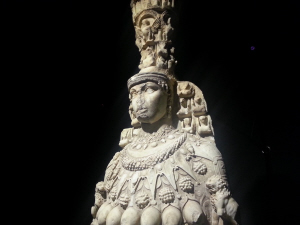
God’s Holy Temple
Ephesus in the first century was the sprawling capital of the province of Asia. Situated in fertile lands with a mild climate, over 250,000 inhabitants populated the region. The city was the second largest in the Roman Empire, filled with ornate and magnificent buildings. Yet rising above the teeming streets and crowded markets was the fabulous Temple of Artemis.
Paul’s epistle to the Ephesians is brimming with architectural language. In Ephesians 2:21, for example, he refers to a temple that is built by God. This raises two questions. (1) How much of Ephesians references God’s temple? (2) Was Paul thinking of the Temple of Artemis as he penned this letter?
We may never know the exact images in the apostle’s mind as he wrote, but a close look at the geographic context and vocabulary of Ephesians will help Christians to better understand this book.
The Temple of Artemis
Antipater of Sidon, who compiled the list of the Seven Wonders of the ancient world, described the Temple of Artemis in this way:
“I have set eyes on the wall of lofty Babylon on which is a road for chariots, and the statue of Zeus by the Alpheus, and the hanging gardens, and the colossus of the Sun, and the huge labour of the high pyramids, and the vast tomb of Mausolus; but when I saw the house of Artemis that mounted to the clouds, those other marvels lost their brilliancy, and I said, “Lo, apart from Olympus, the Sun never looked on aught so grand.”” (Antipater, Greek Anthology [IX.58])
The dimensions of the temple are given by Pliny, who described it as 377 feet long and 180 feet wide. This temple was a gigantic architectural wonder. Demetrius the silversmith referred to “the temple of the great goddess Diana…and her magnificence…whom all Asia and the world worshippeth” (Acts 19:27).
The temple was filled with marble. It had 127 elegant columns supporting the roof, and each column was 60 feet tall. Inside, a titanic statue of the goddess herself peered down aloofly at the worshippers.

The goddess Artemis, or Diana
Though Ephesus was located in fertile ground near the sea, it was the Temple of Artemis that brought her glory. This temple was so grand that travelers from the entire empire came to visit, and a huge city naturally sprang up.
To Christians living in Ephesus, the Temple of Artemis was a symbol of the power and sway of paganism. The soaring columns represented the ancient reign of ‘the prince of the power of the air, the spirit who now works in the sons of disobedience’ (Ephesians 2:2).
A Holy Temple in the Lord – Evidence in Chapter Two
Now, therefore, you are no longer strangers and foreigners, but fellow citizens with the saints and members of the household of God, having been built on the foundation of the apostles and prophets, Jesus Christ Himself being the chief cornerstone, in whom the whole building, being fitted together, grows into a holy temple in the Lord, in whom you also are being built together for a dwelling place of God in the Spirit. (Ephesians 2:19-22)
In Ephesians 2:10, Paul set the stage for ‘temple language,’ by referring to God’s ‘workmanship.’ What is this workmanship? According to Ephesians 2:21, it is ‘a holy temple in the Lord.’
Obviously, Paul is not referring to any human temple. But what sort of temple comes to mind when he writes about a temple? Some think that Paul was alluding to the Jewish temple in Jerusalem. Others think he is imagining the Ephesians temple to Artemis. There is an obvious contextual clue to help us solve this mystery: Paul is writing to Ephesians.
Most of Paul’s audience was unfamiliar with the Jewish Temple, but they would all be familiar with the Temple of Artemis. As they read about God’s holy temple, they would compare it to the idol temple.
God’s Glory in the Church – Evidence in Chapter Three
That you, being rooted and grounded in love, may be able to comprehend with all the saints what is the width and length and depth and height – to know the love of Christ which passes knowledge; that you may be filled with all the fullness of God. Now to Him who is able to do exceedingly abundantly above all that we ask or think, according to the power that works in us, to Him be glory in the church by Christ Jesus to all generations, forever and ever. Amen. (Ephesians 3:17b-21)
Ephesians three is a museum exhibit of Paul’s writing style. The apostle – like many ancient authors – is often distracted from one thought to another. Halfway into 3:1, Paul is distracted from his thought – and spends thirteen verses on a rabbit trail!
“For this cause I,” he says…and then promptly goes on his thirteen verse rabbit trail. Finally, in verse 14, he returns to his theme: “For this reason I bow my knees to the Father.”
What is ‘this cause?’ It is the recognition that Jews and Gentiles are unified in Christ, part of God’s temple. If we put 3:1b-13 in parentheses, the reasoning becomes clear: Paul is bowing in praise to God because Jews and Gentiles are both unified in God’s temple.
Then the apostle asks God to strengthen the Ephesians with might (3:16), and that Christ would dwell in their hearts through faith (3:17). He hopes this will have two results. (1) They will be able to comprehend the length and width and depth and height, and (2) they will know the love of Christ.
Length, Width, Depth, Height
Most people believe these architectural terms refer to the love of Christ. They base this assumption on two arguments.
First, the Greek word ‘te’ – which is either untranslated or translated ‘and’ at the beginning of verse 19 – can be translated ‘even.’
Second, the phrase ‘love of Christ’ is right next to these terms.
There are some problems with these arguments. ‘Te’ could be translated ‘even,’ but that is a rare occurrence. The word is used 26 times in 22 verses in the writings of Paul, but it is only translated ‘even’ twice.
Also, while the dimension terms could refer to ‘the love of Christ,’ this is not clear. Do we think of Christ’s love in architectural terms? Or is it better to think of some building with architectural terms? The best explanation is that these terms refer to God’s temple. Consider four reasons why this is likely.
- Remember, Paul is praying this because the Jews and Gentiles are united in God’s temple. It makes sense that he is referring to this same temple.
- Paul used architectural language when he said “rooted and grounded in love.” The word ‘grounded’ refers to the foundation of a building. The apostle mentioned the foundation of God’s temple in 2:20.
- Theoretically, a temple has dimensions, while Christ’s love does not. Love is an abstract idea that cannot be measured, while a temple can. Of course, God’s temple cannot be literally measured, but if one is referred to, ‘temple’ is more likely than ‘love.’
- None of these terms refer to Christ’s love in any other place in the Bible, but in Revelation 21:16, these terms refer to God’s holy city, which is the church.
In 3:20, Paul says that God is able ‘to do.’ This word (poieo) sometimes refers to ‘making’ a building or habitation (Mark 9:5, Luke 9:33, Hebrews 8:5). Paul probably has this idea: ‘Glory be to the God who can make a temple so grand that we cannot begin to comprehend its final glory!’
The ‘naos’ of the temple – in the Greek language – is the inner sanctuary. In the Temple of Artemis, the ‘naos’ was the shrine; in the Jewish temple, the ‘naos’ referred to the Holy Place, or the Holy of Holies. In 2:21, Paul speaks of the ‘naos’ of God. The ‘naos’ is the place where praise is most glorious – and Paul prays that God would be glorified in the church – His ‘naos!’
To summarize: Paul yearns for believers to realize how grand is the temple that God is building. It is made up of Jews and Gentiles, and its length, width, depth, and height are staggering.

The site of the temple today, picture taken by yours truly!
Conclusion
Ephesians two and three describe God’s temple, implicitly comparing it to the Temple of Artemis. How should this affect Christians today, unfamiliar with the great pagan shrine?
The Ephesians were dead in sins, eager to fulfill sinful desires, children of wrath, uncircumcised Gentiles, aliens from Israel, and hopeless vagabonds (Ephesians 2). Now they are delivered, reconciled to God, and part of his glorious temple. This is a cause for great thankfulness.
Beside thanksgiving, Christians should be encouraged by the grandeur of God’s salvific working. Evil and falsehood are thriving everywhere, to be sure, but just like the Temple of Artemis, they are dwarfed by the incredible work of God. While Satan is busy among the children of disobedience, God is also working through his mighty power. God is making something so grand that we cannot begin to comprehend it. He is building a temple for himself.
The temple that believers are made into is created for one purpose: to glorify God. Christians are the temple, the shrine, the holy place of God, and it is their privilege and duty to praise God.
Glory be to the Master Builder, in the church, by Christ Jesus, through all ages![1]
[1] There is nothing, says one, so august as this Church, seeing it is the temple of God.
Nothing so worthy of reverence, seeing God dwells in it.
Nothing so ancient, since the patriarchs and prophets labored in building it.
Nothing so solid, since Jesus Christ is the foundation of it.
Nothing more closely united and indivisible, since he is the corner stone.
Nothing so lofty, since it reaches as high as heaven, and to the bosom of God himself.
Nothing so regular and well proportioned, since the Holy Spirit is the architect.
Nothing more beautiful, or adorned with greater variety, since it consists of Jews and Gentiles, of every age, country, sex, and condition: the mightiest potentates, the most renowned lawgivers, the most profound philosophers, the most eminent scholars, besides all those of whom the world was not worthy, have formed a part of this building.
Nothing more spacious, since it is spread over the whole earth, and takes in all who have washed their robes, and made them white in the blood of the Lamb.
Nothing so inviolable, since it is consecrated to Jehovah.
Nothing so Divine, since it is a living building, animated and inhabited by the Holy Ghost.
Nothing so beneficent, seeing it gives shelter to the poor, the wretched, and distressed, of every nation, and kindred, and tongue.




Interestingly, I’d never considered that Paul might have had the Ephesians’ own temple to Artemis in mind when wrote his letter, until just a few minutes ago. That makes so much sense. Why wouldn’t he have used what they knew as a basis for the picture he painted of the church? Thank you for that useful insight!
I had to read this 2 times before it all came together. The grandeur of this big picture of God’s house is beautiful in this text. Thanks Daniel for your research and work on this. I will ponder this as it relates to the Church the kingdom and the new Jerusalem.